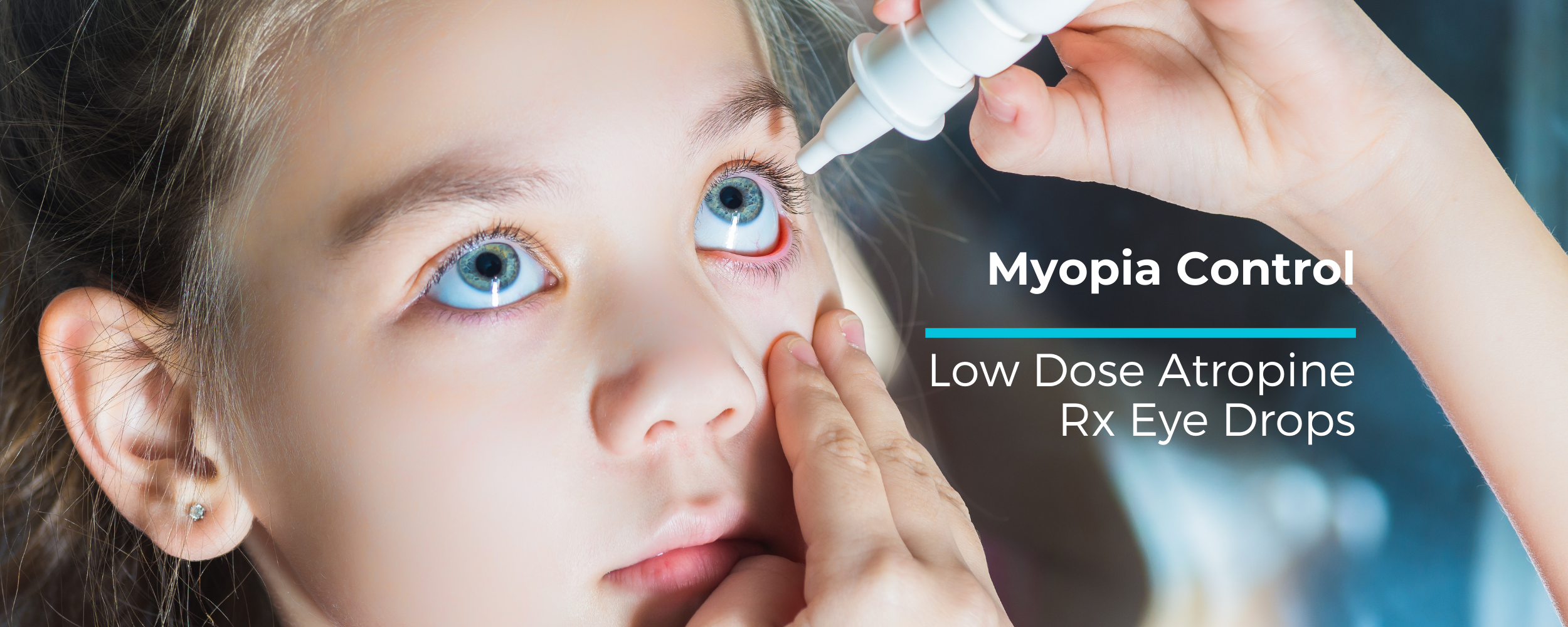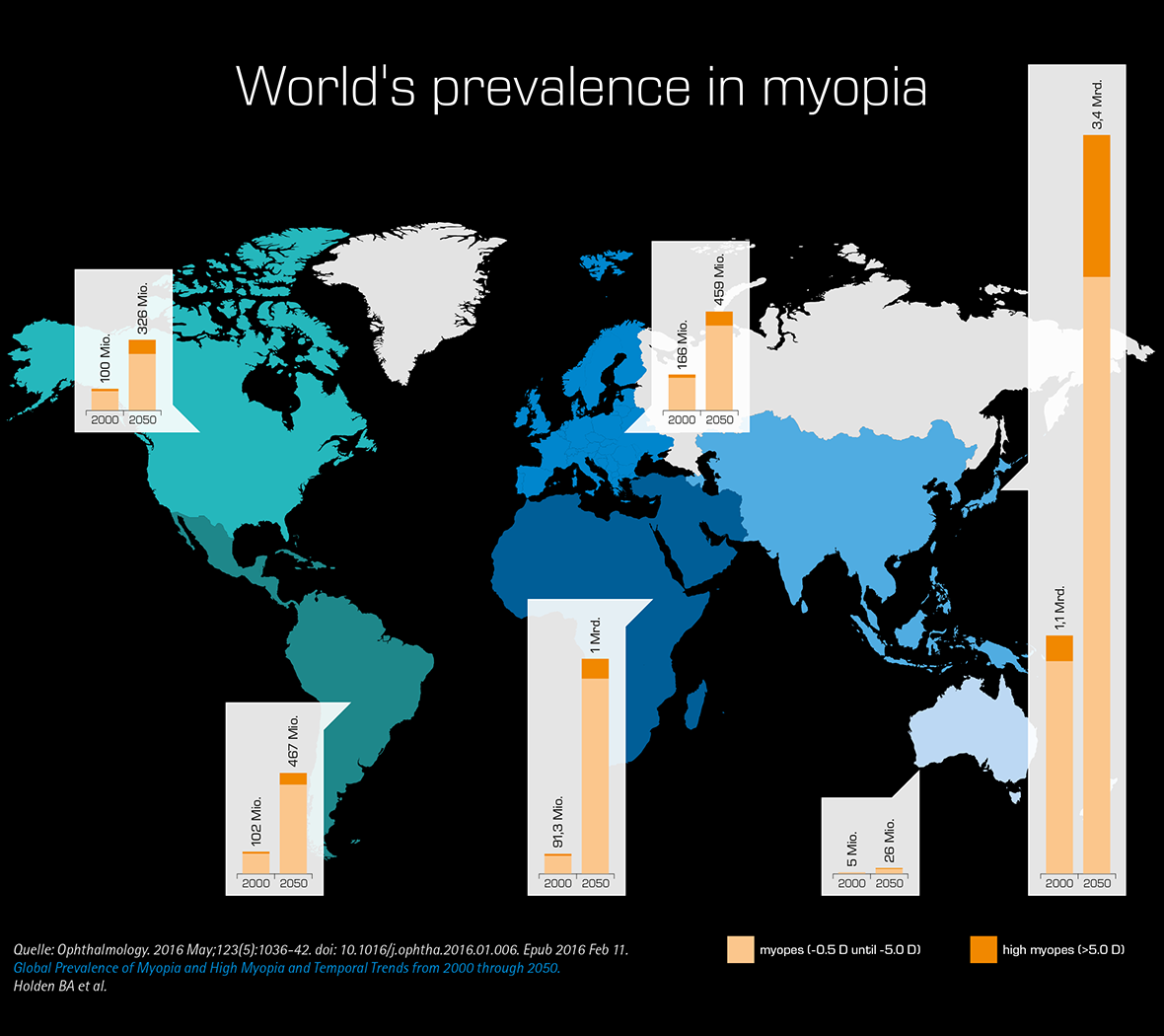Myopia Management
What is myopia?
Myopia, also known as ‘short-sightedness’ is a vision condition that every parent should be aware of but may not know about. For those with myopia, near objects will be clear, while far objects will appear blurry. This can be because the eyeball is too long, or the front surface of the eye (the cornea) is too curved, causing light to fall out of focus. The cause of myopia is still unknown, but there is evidence that it can be inherited, or occur due to environmental and health issues.
At Clearview, our optometrists have a special interest in managing the progression of myopia in both children and adults. They are continually educated with the latest clinical techniques for managing myopia in practice, and are able to answer concerns you may have regarding myopia.
Management options
If your child has been diagnosed with short-sightedness, the following management options are available to prevent his or her eyes from progressing worse:
Optical Treatments
Pharmaceutical Treatments
OCULUS MYOPIA MASTER
The Myopia Master from OCULUS, is an all-in-one device for performing refractive, axial length measurement and keratometry in combination. The most common parameter to monitor myopia progression is change in refractive error (the strength of the spectacle prescription). However, as clinicians around the world become more proactive with prescribing myopia control strategies, axial length data becomes an increasingly valued piece in the clinical picture.
The main ‘why’ behind myopia control is to reduce the rate of axial length (length of the eye) elongation. Whilst we can normally expect a direct correlation between axial length and refractive error, this is not always the case. A reduction in refractive progression does not always correlate to reduced axial length progression. Axial length measurements are also a valuable tool in monitoring the success of orthokeratology treatment in reducing myopic progression, as refraction is intentionally altered. It can also change one’s clinical management plan, such as in cases of a mismatch between myopia and axial length. An example of this is a low myope with long axial length, where a higher-than-expected risk for future pathology may lead to a more proactive management strategy.
The Myopia Master provides early and accurate measurement and reliable follow-up of myopia. With myopia prevalence increasing in children, adolescents and young adults and growing exponentially overall, it is becoming more and more important to monitor for myopia early on in life. Simply put: The earlier myopia is discovered, the better. Children should therefore be regularly tested for myopia from the age of 4.
The greatest changes in myopia occur from age 6 to 16 when the eye can start growing out of focus. This results into a bigger axial length of the eye and myopia. Once the eye is grown longer, there is no method shrinking the eye again. The treatment of myopia reduces the eye growth, or, in the best case, stops it. This demonstrates how important it is to regularly test children already at an early age.
At Clearview Eyecare Burwood, we are one of few Optometry Practices in Sydney to utilise the Myopia Master by Oculus as part of our myopia management program for your child.
ORTHOKERATOLOGY
Orthokeratology, or ortho-k, is the use of specially designed and fitted contact lenses to temporarily reshape the cornea to improve vision. Most ortho-k lenses are worn at night to reshape the front surface of the eye while you sleep. Vision improvements are reversible but can be maintained if you keep wearing the lenses as directed.
WHAT CAN YOU EXPECT FROM ORTHOK-K?
It can take two weeks or longer to attain the maximum vision correction from orthokeratology, although some people experience significant vision improvement in days. In clinical studies of Food and Drug Administration-approved ortho-k lenses, most patients achieved clear vision close to 20/20 vision.
You may need a series of temporary ortho-k lenses to see properly until you reach the desired prescription. Once you’ve reached the desired prescription, you’ll use the same shape of lens each night to maintain the correction.
Until you get used to them, you will probably feel the lenses on your eyes until you fall asleep. With time, they usually become more comfortable.
IS ORTHO-K SAFE?
Ortho-k is associated with an increased risk of bacteria infection. This risk is especially concerning for children and adolescents, who may be less able than adults to maintain good hand and contact lenses hygiene.
The biggest risk factor for eye infections is contact lens wear related. Eye infections can have serious consequences including lifelong vision impairment. The risks of eye infections with Orthok-K contact lenses are very similar to the risks of wearing any type of contact lenses.T hat’s one of the reasons it is important to consult with our Optometrists if you are considering ortho-k.
There is no limit to how long you can use orthokeratology lenses. You must see your Optometrist for regular check-ups. But if your eyes stay healthy and comfortable, ortho-k could be used for years.
Discover the benefits of orthokeratology (Ortho-K) contact lenses at Clearview Eyecare Burwood, in Sydney. Our specially designed lenses gently reshape the cornea overnight, offering clear, lens-free vision during the day. Ideal for those with myopia, Ortho-K lenses are safe, non-surgical, and perfect for active lifestyles. Book a consultation today to experience clear, comfortable vision without daytime contacts or glasses!
DUAL FOCUS (MULTI-FOCAL) CONTACT LENSES
COOPERVISION MISIGHT 1-DAY Disposable Soft Contact Lenses
CooperVision MiSight contact lenses are specially designed daily disposable lenses developed for children aged 8-12 with myopia (nearsightedness). These lenses use a unique ActivControl™ Technology, which is clinically proven to not only correct vision but also help slow down the progression of myopia over time. By creating a particular treatment zone within the lens, MiSight contacts manage the eye’s growth and focus, reducing the long-term impact of nearsightedness. MiSight lenses offer a convenient, comfortable, and effective solution for young wearers, allowing them to enjoy clear vision without the need for glasses. These lenses are easy to use, hygienic, and supportive of an active lifestyle, making them a trusted option for parents and a preferred choice for children.
Discover CooperVision MiSight contact lenses at Clearview Eyecare Burwood, in Sydney designed specifically for myopia control in children. These FDA-approved daily disposable lenses slow myopia progression, offering clear vision and promoting eye health. Visit Clearview Burwood to learn more and get a personalized fitting for your child today!
VTI NATURAL VUE 1 DAY DISPOSABLE SOFT CONTACT LENSES
NaturalVue (etafilcon A) Multifocal 1 day contact lenses are proven to decrease myopia progression in paediatric myopia patients. These contact lenses feature a patented neurofocus optics technology with an extended depth of focus (EDOF), centre distance design.
MYOPIA CONTROL SPECTACLES
HOYA MIYOSMART LENSES WITH D.I.M.S. TECHNOLOGY FOR MYOPIA MANAGEMENT
The much anticipated launch of MiyoSmart lenses with D.I.M.S. Technology in Australia and New Zealand has arrived. Hoya Lens Australia have launched the innovative lens, which features award winning technology.
MiyoSmart® is an innovative spectacle lens for myopia control developed by Hoya together with its research partner, The Hong Kong Polytechnic University. Based on a two-year clinical trial results, MiyoSmart® is proven to curb myopia progression by up to 59% and halt myopia progression by 21.5% 3 with its award-winning D.I.M.S. (Defocus Incorporated Multiple Segments) technology.
1. D.I.M.S. Technology
MiyoSmart® with D.I.M.S. technology is comprised of a central optical zone for correcting refractive error and multiple defocus segments evenly surrounding the central zone (extending to the mid-periphery) of the lens to control myopia progression.
This provides clear vision and myopic defocus simultaneously at all viewing distances. The lens makes use of the natural homeostatic mechanism known as “emmetropisation”, whereby the eyeball adapts and shapes to receive focused images as it does for normal vision.
- Curb myopia progression on average by 59%
- Slow axial eye growth on average by 60%
- Halts myopia progression in 21.5% of Children
2. EYE SHIELD
As children are active, there is a need for the lens material to be impact-resistant to provide their eyes the protection they need. MiyoSmart®
uses polycarbonate 1.59 which is a highly impact resistant material that has passed the high velocity impact drop ball test.4
- Impact-resistant material safe for active kids
- Provides UV protection
- Is light and thin
Discover Hoya Miyosmart lenses at Clearview Eyecare Burwood, in Sydney – advanced lenses specifically designed to slow myopia progression in children. These innovative lenses offer clear, comfortable vision and a clinically proven solution to manage nearsightedness effectively. Visit Clearview Eyecare to learn more about the benefits of Miyosmart lenses and schedule a consultation to support your child's eye health with the latest in myopia control technology.
COMPOUNDED ATROPINE EYEDROPS
Atropine eye drops have been shown to slow progression of myopia and their use is gaining popularity.
MYOPIA TODAY & TOMORROW
MYOPIA: SHORT-SIGHTEDNESS IN CHILDREN AND ADOLESCENTS ON THE RISE
When it comes to the spread of myopia some studies already speak of an epidemic. The well-known Brien Holden Vision Institute has forecast that by the year 2050 one out of two individuals could be affected by myopia. That is alarming, and it makes it more than clear that early detection and management of myopia are becoming more and more important. For there is no other way to effectively reduce the risks of myopia in children and adolescents.
NUMBERS SPEAK A CLEAR LANGUAGE
A comparison illustrates the rapidity of this development: In the year 2000 22.9% of the global population were affected by myopia and 2.7% had high myopia beyond -5 diopters. According to Brien Holden's forecast, by 2050, 50% of the world's population could be myopic and at least 10% could be suffering from high myopia. The development is also dramatic within Europe. According to data recently presented by the European Eye Epidemiology Consortium, more than 47% Europeans between 25 and 29 years of age are myopic
RISK OF SEVERE EYE DISEASE ON THE RISE
Those affected also have a greater risk of developing severe eye disease such as cataract or retinal detachment and eventual blindness. In general it can be said, that the earlier the myopia onset, the higher will be the myopia in the adulthood and the higher will be the risk for severe eye disease.













